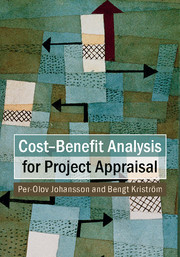Book contents
- Frontmatter
- Dedication
- Contents
- List of illustrations
- List of tables
- Preface
- 1 Introduction
- 2 The basic cost–benefit (C–B) model
- 3 Market distortions
- 4 Intertemporal generalization
- 5 Natural resources
- 6 Small versus large projects
- 7 Aggregation
- 8 Appraisal in a risky world
- 9 Notes on estimation techniques
- 10 A smörgåsbord of further topics
- 11 Robustness checks and due diligence in evaluations
- References
- Index
9 - Notes on estimation techniques
Published online by Cambridge University Press: 05 November 2015
- Frontmatter
- Dedication
- Contents
- List of illustrations
- List of tables
- Preface
- 1 Introduction
- 2 The basic cost–benefit (C–B) model
- 3 Market distortions
- 4 Intertemporal generalization
- 5 Natural resources
- 6 Small versus large projects
- 7 Aggregation
- 8 Appraisal in a risky world
- 9 Notes on estimation techniques
- 10 A smörgåsbord of further topics
- 11 Robustness checks and due diligence in evaluations
- References
- Index
Summary
Ideally, there are perfect markets for the good(s) under evaluation, in which case the equilibrium price provides information with respect to the marginal WTP for the good. However, for many goods and services there are no markets and other approaches are needed for valuation of these goods/services. Two broad categories of approaches are available. One approach draws on prices in markets related to the good under evaluation, for example, gasoline is needed in order to make a trip to a natural park, and the market price of a home might reflect the value of local environmental attributes. Using econometric techniques we can estimate the value of or WTP for the environmental attributes. Such methods are revealed preference methods or surrogate market methods. These methods can be used to estimate use values but are unable to capture non-use values. This last property is due to the fact that non-use values leave no “fingerprint” in markets.
The second approach collects information through surveys (face-to-face interviews, telephone interviews, mail surveys, or interactive computer programs). For example, a sample of people might be asked about their WTP for a set of environmental attributes or a program increasing survivor probabilities. This is referred to as the contingent valuation method, first used by a consulting company in 1958, Davis (1963) is considered the first academic application; the seminal work on this method is Mitchell and Carson (1989). Alternatively, the sample is confronted with attributes of the scenario and these attributes are varied, allowing respondents to accept or reject a particular change in the attributes. This approach for assessing the marginal WTP, developed by marketing researchers in the 1960s, is often termed conjoint analysis: a later and more general variation is termed (discrete) choice Experiments. These survey-based methods are known as stated preference methods or non-market methods. A recent nontechnical review and assessment of stated preference and revealed preference methods is found in Freeman III (2014). The econometrics of stated preference methods is examined by Aizaki et al. (2014), using the free software R to implement all methods, with code, packages, and datasets available online. Bockstael and McConnell (2007) provide extensive coverage of revealed preference methods.
Information
- Type
- Chapter
- Information
- Cost-Benefit Analysis for Project Appraisal , pp. 161 - 189Publisher: Cambridge University PressPrint publication year: 2015
